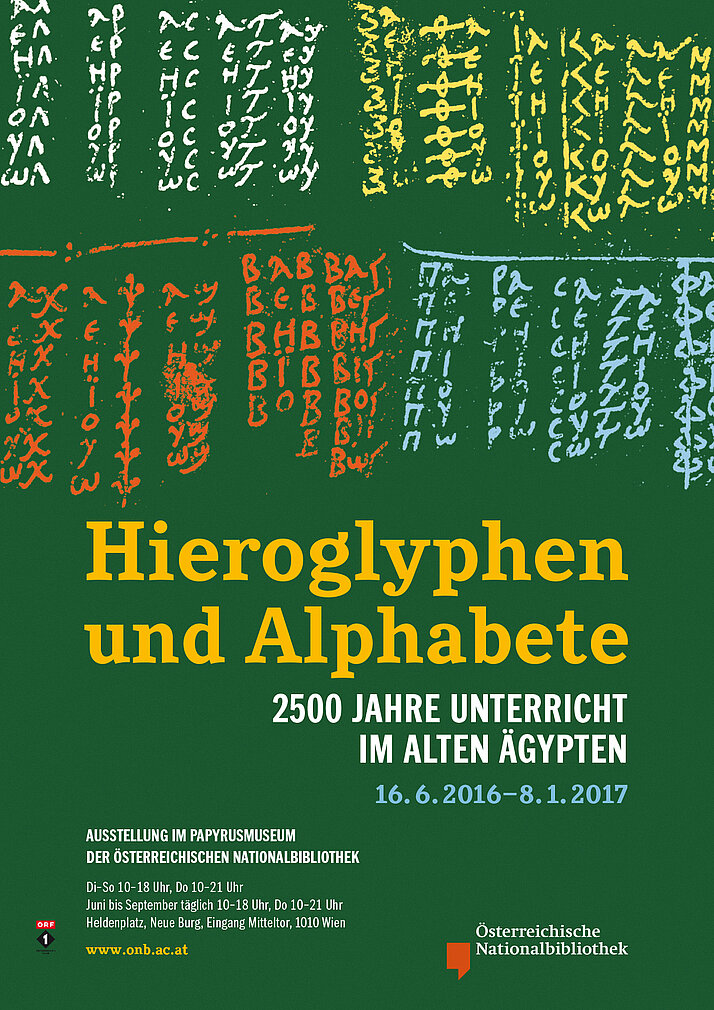Duration: June 16 2016 - January 8 2017
"Hieroglyphs and Alphabets" is the title of the new special exhibition at the Papyrus Museum of the Austrian National Library. It presents over 75 remarkable objects made of papyrus, parchment, paper and clay, which provide impressive evidence of the teaching system of ancient Egypt. Dictations and school essays, but also mathematical tables, arithmetic problems and the remains of ancient textbooks on geometry raise questions that still concern us today: How important is free access to knowledge, how important is elite education? And how do we deal with multilingualism in education and administration? The documents on display date back to the time of the Pharaohs, Greeks and Romans and extend as far as the early Arabic Middle Ages. First, shaky attempts at writing and clumsy writing exercises can be discovered as well as sophisticated copying and style exercises. The contact with written documents from pupils and teachers from over 2,500 years of teaching provides an exciting insight into cultural-historical and social phenomena and still transports you into the everyday lives of people of that time.
Knowledge is power
In the Egypt of the pharaohs, knowledge was power and writing and calculating was an elitist affair: only priests, state officials and professional scribes were proficient in the complicated hieroglyphic script, and schools only existed in the form of expensive private lessons. Most people, especially in rural areas, were illiterate and had to hire professional scribes and literate readers for lease agreements or marriage certificates. Centuries later, Greek and Latin script, Coptic and finally Arabic, each with a manageable number of letters, offered much better conditions for the literacy of larger population groups. But even then, private tuition was expensive and therefore only accessible to the upper classes.
Education without compulsory schooling
The ancient teaching and education system therefore had very little in common with today's ideas of an education system: there was no compulsory schooling and no generally binding school education defined in any way; neither curricula nor textbooks adapted to the age of the pupils have survived. Pupils - mastery of writing was almost exclusively a male domain in antiquity - rarely had their own writing materials to hand: they practised on already inscribed, out-of-date documents. Some of the papyrus sheets on display are therefore fully inscribed in all directions, so that the lines lie on top of each other.
Teaching in antiquity was also individualised and free. Teachers were privately paid educated people and scholars who had to make their teaching appear attractive to their competitors. The level of school education varied accordingly, which is also clearly reflected in the papyri.
Nevertheless, it is possible to recognise a three-stage pattern in which free action was taken. The first stage involved the acquisition of basic reading, writing and arithmetic skills, which were taught by an elementary teacher (Greek grammatistes or Latin ludi magister) in addition to the "pre-school" education provided by the parents.
The gymnasion was a school for boys from the privileged classes, which was usually financed by donations from wealthy citizens and private foundations. Lessons lasted until the age of 17 and, in addition to physical training, focussed on improving language skills by reading important epic poets, lyricists, playwrights, historians and orators.Once the pupils had completed the gymnasium, they attended rhetorical schools to perfect their written and oral expression.
Writing and arithmetic exercises
In ancient times, education and teaching were predominantly oral. This makes the exhibited papyri all the more significant, as they are the only evidence of the acquisition of writing in ancient cultures. At the beginning, the individual letters were learnt until the entire alphabet was finally mastered. It can be seen several times that the alphabet not only had to be written (and recited) in the usual sequence, but also backwards.
The next step was to combine individual letters into syllables. This exercise was probably necessary because the ancient world did not separate words or punctuation marks in its literary books either, but wrote everything down in scriptio continua - as if "in a sausage"; this meant that the individual words and sentence structures could not be recognised in the writing, but only when they were read.
Finally, the third stage was about being able to write down texts as accurately as possible, but also aesthetically. This was practised in copying exercises of literary or theological texts or with dictations. The text of one such dictation can be seen in the exhibition: the story of the "patricide". It was a writing exercise and at the same time a pedagogical message and moral exhortation.
In mathematics, the papyri reveal similar methods and objectives: Firstly, the numbers and number systems had to be learnt, then the consecutive number series and finally the additions, multiplications and divisions. All these arithmetic operations were summarised in clearly arranged tables. Fractions were also important for bookkeeping and business transactions. As there was no arithmetic in decimals at that time, tables were the easiest way to learn how to deal with fractions or to have them to hand for reference. Geometry also played an important role in maths lessons. The calculation of areas had a very concrete and practical background in the land on the Nile, where all the fields and plots of land had to be remeasured after the annual flooding.
< he following special exhibition To the previous exhibition >

